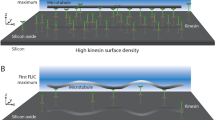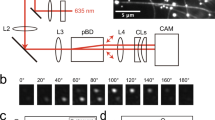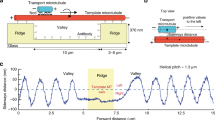Abstract
The dimeric motor protein kinesin-1 converts chemical energy from ATP hydrolysis into mechanical work used to transport cargo along microtubules1,2. Cargo attached to the kinesin stalk moves processively in 8-nm increments3 as its twin motor domains (heads) carry out an asymmetric, ‘hand-over-hand’ walk4,5,6,7. The extent of individual head interactions with the microtubule during stepping, however, remains controversial4,8,9,10,11,12,13,14. A major experimental limitation has been the lack of a means to monitor the attachment of an individual head to the microtubule during movement, necessitating indirect approaches. Here we report the development of a single-molecule assay that can directly report head binding in a walking kinesin molecule, and show that only a single head is bound to the microtubule between steps at low ATP concentrations. A bead was linked to one of the two kinesin heads by means of a short DNA tether and used to apply rapidly alternating hindering and assisting loads with an optical trap. The time-dependent difference between forwards and backwards displacements of the bead alternated between two discrete values during stepping, corresponding to those intervals when the linked head adopted a bound or an unbound state. The linked head could only rebind the microtubule once ATP had become bound to its partner head.
This is a preview of subscription content, access via your institution
Access options
Subscribe to this journal
Receive 51 print issues and online access
$199.00 per year
only $3.90 per issue
Buy this article
- Purchase on Springer Link
- Instant access to full article PDF
Prices may be subject to local taxes which are calculated during checkout




Similar content being viewed by others
References
Block, S. M. Kinesin motor mechanics: binding, stepping, tracking, gating, and limping. Biophys. J. 92, 2986–2995 (2007)
Vale, R. D. The molecular motor toolbox for intracellular transport. Cell 112, 467–480 (2003)
Svoboda, K., Schmidt, C. F., Schnapp, B. J. & Block, S. M. Direct observation of kinesin stepping by optical trapping interferometry. Nature 365, 721–727 (1993)
Yildiz, A., Tomishige, M., Vale, R. D. & Selvin, P. R. Kinesin walks hand-over-hand. Science 303, 676–678 (2004)
Kaseda, K., Higuchi, H. & Hirose, K. Alternate fast and slow stepping of a heterodimeric kinesin molecule. Nature Cell Biol. 5, 1079–1082 (2003)
Asbury, C. L., Fehr, A. N. & Block, S. M. Kinesin moves by an asymmetric hand-over-hand mechanism. Science 302, 2130–2134 (2003)
Hackney, D. D. Evidence for alternating head catalysis by kinesin during microtubule-stimulated ATP hydrolysis. Proc. Natl Acad. Sci. USA 91, 6865–6869 (1994)
Yildiz, A., Tomishige, M., Gennerich, A. & Vale, R. D. Intramolecular strain coordinates kinesin stepping behavior along microtubules. Cell 134, 1030–1041 (2008)
Mori, T., Vale, R. D. & Tomishige, M. How kinesin waits between steps. Nature 450, 750–754 (2007)
Alonso, M. C. et al. An ATP gate controls tubulin binding by the tethered head of kinesin-1. Science 316, 120–123 (2007)
Hackney, D. D. The tethered motor domain of a kinesin-microtubule complex catalyzes reversible synthesis of bound ATP. Proc. Natl Acad. Sci. USA 102, 18338–18343 (2005)
Kawaguchi, K., Uemura, S. & Ishiwata, S. Equilibrium and transition between single- and double-headed binding of kinesin as revealed by single-molecule mechanics. Biophys. J. 84, 1103–1113 (2003)
Mandelkow, E. & Hoenger, A. Structures of kinesin and kinesin-microtubule interactions. Curr. Opin. Cell Biol. 11, 34–44 (1999)
Asenjo, A. B. & Sosa, H. A mobile kinesin-head intermediate during the ATP-waiting state. Proc. Natl Acad. Sci. USA 106, 5657–5662 (2009)
Block, S. M., Asbury, C. L., Shaevitz, J. W. & Lang, M. J. Probing the kinesin reaction cycle with a 2D optical force clamp. Proc. Natl Acad. Sci. USA 100, 2351–2356 (2003)
Taniguchi, Y., Nishiyama, M., Ishii, Y. & Yanagida, T. Entropy rectifies the Brownian steps of kinesin. Nature Chem. Biol. 1, 342–347 (2005)
Sindelar, C. V. & Downing, K. H. The beginning of kinesin’s force-generating cycle visualized at 9-Å resolution. J. Cell Biol. 177, 377–385 (2007)
Kikkawa, M. & Hirokawa, N. High-resolution cryo-EM maps show the nucleotide binding pocket of KIF1A in open and closed conformations. EMBO J. 25, 4187–4194 (2006)
Hwang, W., Lang, M. J. & Karplus, M. Force generation in kinesin hinges on cover-neck bundle formation. Structure 16, 62–71 (2008)
Ma, Y.-Z. & Taylor, E. W. Interacting head mechanism of microtubule-kinesin ATPase. J. Biol. Chem. 272, 724–730 (1997)
Gilbert, S. P., Moyer, M. L. & Johnson, K. A. Alternating site mechanism of the kinesin ATPase. Biochemistry 37, 792–799 (1998)
Crevel, I., Carter, N., Schliwa, M. & Cross, R. Coupled chemical and mechanical reaction steps in a processive Neurospora kinesin. EMBO J. 18, 5863–5872 (1999)
Klumpp, L. M., Hoenger, A. & Gilbert, S. P. Kinesin’s second step. Proc. Natl Acad. Sci. USA 101, 3444–3449 (2004)
Rosenfeld, S. S., Fordyce, P. M., Jefferson, G. M., King, P. H. & Block, S. M. Stepping and stretching. How kinesin uses internal strain to walk processively. J. Biol. Chem. 278, 18550–18556 (2003)
Guydosh, N. R. & Block, S. M. Backsteps induced by nucleotide analogs suggest the front head of kinesin is gated by strain. Proc. Natl Acad. Sci. USA 103, 8054–8059 (2006)
Rice, S. et al. A structural change in the kinesin motor protein that drives motility. Nature 402, 778–784 (1999)
Sablin, E. P. & Fletterick, R. J. Coordination between motor domains in processive kinesins. J. Biol. Chem. 279, 15707–15710 (2004)
Lang, M. J., Asbury, C. L., Shaevitz, J. W. & Block, S. M. An automated two-dimensional optical force clamp for single molecule studies. Biophys. J. 83, 491–501 (2002)
DeLano, W. L. PyMOL Molecular Viewer version 1.0r1. 〈http://www.pymol.org〉 (2002)
Kerssemakers, J. W. et al. Assembly dynamics of microtubules at molecular resolution. Nature 442, 709–712 (2006)
Fehr, A. N., Gutiérrez-Medina, B., Asbury, C. L. & Block, S. M. On the origin of kinesin limping. Biophys. J. (in the press)
Acknowledgements
We thank A. Dunn, B. Choi and W. Hwang for advice on labelling kinesin; S. Gilbert for advice on expressing kinesin; and B. Gutiérrez-Medina, C. Sindelar, C. Perez and K. Frieda for comments on the manuscript. This work was supported by grant GM51453 from the US National Institutes of Health.
Author Contributions N.R.G. designed the project, expressed and labelled the protein, and collected and analysed data. N.R.G. and S.M.B. discussed the data and co-wrote the manuscript.
Author information
Authors and Affiliations
Corresponding author
Supplementary information
Supplementary Information
This file contains Supplementary Figures 1-7 with Legends and a Supplementary Discussion. (PDF 2094 kb)
Rights and permissions
About this article
Cite this article
Guydosh, N., Block, S. Direct observation of the binding state of the kinesin head to the microtubule. Nature 461, 125–128 (2009). https://doi.org/10.1038/nature08259
Received:
Accepted:
Published:
Issue Date:
DOI: https://doi.org/10.1038/nature08259
This article is cited by
-
Structural basis of mechano-chemical coupling by the mitotic kinesin KIF14
Nature Communications (2021)
-
Additive manufacturing of laminar flow cells for single-molecule experiments
Scientific Reports (2019)
-
Crystal structure of Zen4 in the apo state reveals a missing conformation of kinesin
Nature Communications (2017)
-
Detectable states, cycle fluxes, and motility scaling of molecular motor kinesin: An integrative kinetic graph theory analysis
Frontiers of Physics (2017)
-
Direct observation of intermediate states during the stepping motion of kinesin-1
Nature Chemical Biology (2016)
Comments
By submitting a comment you agree to abide by our Terms and Community Guidelines. If you find something abusive or that does not comply with our terms or guidelines please flag it as inappropriate.



